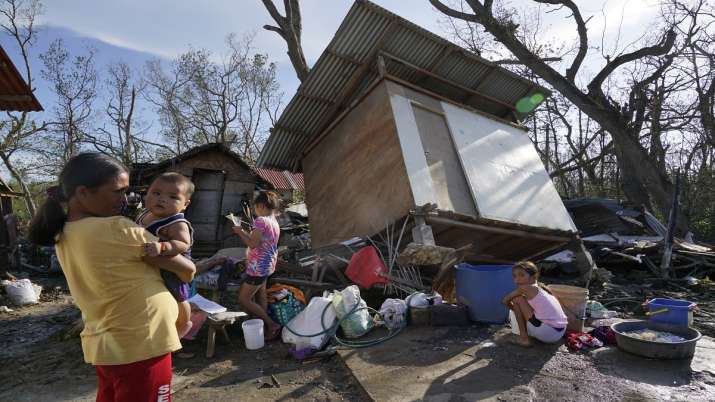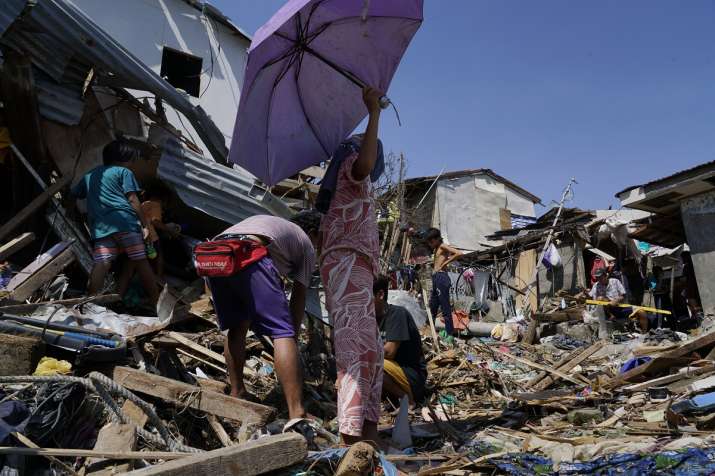
Residents stand among houses damaged after Hurricane Rai in Talisay
Highlight
- Typhoon Rai’s death toll stood at 146 on Sunday.
- Officials were trying to confirm the large number of deaths from landslides, widespread flooding.
- At least 64 other typhoon deaths were reported by the disaster-response agency.
The governor of an island province in the central Philippines said on Sunday that at least 72 people were killed in the devastation caused by Typhoon Rai in more than half the cities it approached, making it the deadliest typhoon to batter the country. The number of people increased. At least 146 from the year.
Governor Arthur Yap of Bohol province said 10 others were missing and 13 were injured, and suggested the death toll could still rise significantly as only 33 of the 48 mayors were able to report them back due to downed communications. Officials were trying to confirm a high number of deaths due to landslides and widespread flooding elsewhere.
In statements posted to Facebook, Yap ordered more than 1.2 million people in his province to apply his emergency powers to secure food packs for a large number of people with drinking water. Both have been immediately searched in many inaccessible cities.
After engaging in a military aerial survey of cities devastated by the storm, Yap said, “It is very clear that the damage from Bohol is huge and widespread.” He said the initial inspection did not cover the four cities where thunderstorms tore through the central island provinces on Thursday and Friday. The government said about 780,000 people were affected, including more than 300,000 residents who had to evacuate their homes.
Residents salvage parts of their damaged homes after Typhoon Rai in Taliesai
At least 64 other deaths from the typhoon were reported by the disaster-response agency, national police and local officials. Most were affected by falling trees and walls, drowned in floods or buried in landslides. Authorities in the Dinagat Islands, one of the southeastern provinces first hit by the typhoon, reported 10 isolated deaths from some cities, bringing the total deaths so far to 146. President Rodrigo Duterte flew into the region on Saturday and promised 2 billion pesos ($40). million) aid.
He met with officials in the city of Maasin in southern Leyte province where he was born. Duterte’s family later relocated to the southern city of Davao, where he served as mayor for a long time before rising to the presidency. “The moment I was born into this world, I told my mother, ‘Let’s not stay here because this place is really prone to thunderstorms,'” Duterte told officials.
At its strongest, the typhoon packed sustained winds of 195 kph (121 mph) and gusts of 270 kph (168 mph), making it the disaster-prone archipelago in recent years. Became one of the most powerful to hit, which is a lie. Between the Pacific Ocean and the South China Sea.
Flood waters rose rapidly in Bohol’s riverside town of Lobok, where residents were trapped in their roofs and trees. They were rescued by the Coast Guard the next day.
On the Dinagat Islands, an official said the roofs of almost all homes, including emergency shelters, were either damaged or completely blown up. Power went out in at least 227 cities and towns, which has been restored in only 21 areas, officials said, adding that three regional airports were damaged, two of which are closed.
The typhoon deaths and widespread damage before Christmas in the largely Roman Catholic nation brought back memories of the devastation caused by another hurricane, Haiyan, one of the most powerful on record.
It affected several central provinces last week, killing more than 6,300 people in November 2013. At the Vatican, Pope Francis expressed his closeness to the people of the Philippines on Sunday, referring to the storm that “destroyed many homes.” About 20 hurricanes and tornadoes occur each year in the Philippines. The archipelago is also located along the seismically active Pacific “Ring of Fire”, making it one of the countries most susceptible to natural disasters.
,
